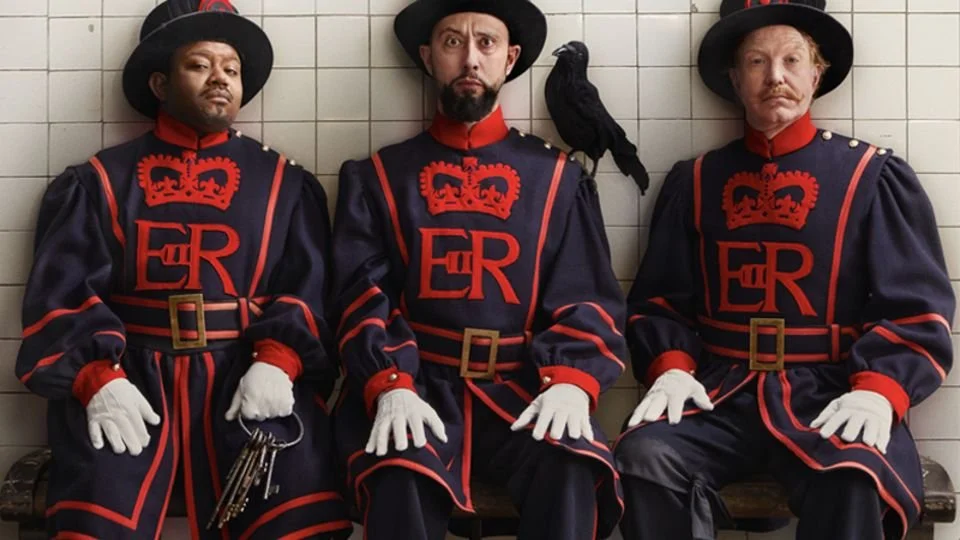HERE WE ARE - by SONDHEIM
A Sondheim is often a show of two halves. And this is in more than the sense of Acts 1 and 2. He loved to play with an audience’s expectations: a light frothy first hour followed by a much darker, introspective narrative after the interval ice cream. ‘Into The Woods' does this with its jolly fairy tale scenes followed by heavier-going philosophising. This is also true of Stephen Sondheim's swansong work, ‘Here We Are' which is playing here and now at the Lyttelton on the South Bank.
The show was completed shortly before his death at the age of 91 in 2021. For Sondheim fans, I am one, his passing albeit at way past biblical time, came as a devastating blow. He was,without doubt, the presiding genius of music theatre in the second half of the 20h century.
You can imagine then with what anticipation his devotees awaited his final work. They did so with some trepidation as the reviews coming out of the Broadway first productions last year, and this first London run, were to say the least, not complimentary. There was a general view amongst my critical colleagues that the old chap had run out of steam, road, space, creative juices or ink. There was in the air that unmistakable pong of ageism. How could a 90 year-old write anything new, fresh, envigorating – especially in the afterglow of the towering ‘Hamilton'? Even the mum of one its stars, Rory Kinnear, didn't think it was any good (according to the lady in the next seat to mine).
So what did I think? As I said this is a show of two halves – the second one to be fair got a bit tedious, too dark for its own good; but the first, oh the first. I loved every second. It fizzed with Sondheimian tunes (including a rather lovely ballad still earwormed into my skull) and was packed with his trademark wit and acerbic lyrics. OK it may not have been the best feast of St Stephen, but it had all of his sharp audacity and satirical edge.
The show begins in a glowing white light, white stage, mirrored like some contemporary Versailles. Into this space come a chattering and excited group. We are in New York and these are the composer’s usual Upper Back-siders: rich, privileged, fashion and diet-conscious empty heads who seek nothing more than the perfect Manhattan brunch. To help them find their goal is Leo Brink, a millionaire who can’t be asked to get out of his track suit. Mrs Kinnear’s son plays the part with athletic panache (though sometime wobbly US accent). The rest of the unloveable crew are composed of Leo’s entourage – his dumb wife in a negligee, a would-be revolutionary, a mothballed lothario and later a disaffected bishop who can’t even keep the holy wafers crisp.
We are in the world of Luis Buñuel whose two films inspired Sondheim to write this work with his librettist Daviid Ives. The ‘Discreet Charm of the Bourgeoisie’ and ‘Exterminating Angel” provide the settings for Sondheim’s most surreal work. The characters are pawns in a satirical game, cyphers for decadence. It is impossible to feel anything for them though the lady in the nightie does have a kind of epiphany on the meaning of life in her conversation with the bishop. In the first half, the group is frustrated in its attempt to get served with food and there is a particularly hilarious scene in the first of the several restaurants. Here the old composer is at his best with spikey tunes and an avalanche of clever lyrics particularly around the food and drink menus that fail to deliver.
The lighting design of the show is outstanding (again especially in the first half) and the choreographed movements of the characters is done with Swiss-clock precision. In the second half, things change. We are now in the marbled drawing room of a foreign embassy and our characters find themselves trapped by some mysterious force. They cannot leave and there is no food to eat. Added to their woe is a manic butler – a creature from hell – who carries a loaded pistol. Their world has collapsed and with it, the music that accompanied them. An on-stage piano loses its tinkle and the orchestra in the pit lays down its instruments. The baton is packed away. We are now in music theatre with no music. It’s a very bold move. Even the incidental music ceases and won’t come back until the very end. The songs have ended, and in a strangely prescient way, Sondheim himself has fallen silent. But it’s not the no-music format that fails to deliver this disappointing Act. The trapped troupe start to bicker, to panic and to lose their cool, their Big Apple is rotting. It’s all a bit predictable and because we don’t care much about these avatars, we don’t give more than one hoot for their situation. And the whole thing is too long.
That said the characters who are in some kind of Groundhog Day repetition of their lives, return to their white space just before the end. The band strikes up again though the lyrics are no more. In a flash, literally, the show is over and so too is the voice of Stephen Sondheim.
PHOTO CREDIT: MARC BRENNER
https://www.nationaltheatre.org.uk/productions/here-we-are/









